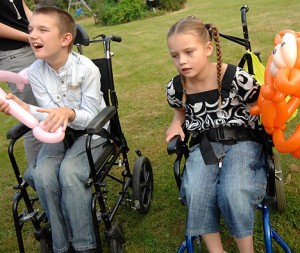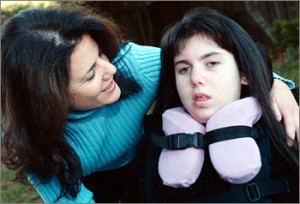Is a child in your family showing vision problems and suffering from seizures? Watch out, for he/she could be having a condition called Batten disease (BD). Know all about this neurological disease, including its causes, symptoms, diagnosis and treatment.
What is Batten Disease?
Page Contents
It is a rare neurodegenerative disorder that develops in children between 5-10 years of age. It belongs to the group of disorders known as neuronal ceroid lipofuscinosis (NCL). The disease is autosomal recessive; which means that it occurs in a child only when he gets two copies of the defective gene, one from each of his parents. The condition was named after the scientist Frederick Batten, who was the first person to give a detailed description of the causes and symptoms of BD.
Batten Disease Incidence
A rare disease, BD has a low prevalence worldwide. The condition is more common in countries like Finland, Norway and Sweden while it occurs rarely in the U.K and U.S. It develops in 1 out of 12500 newborns in Finland while in U.S it is observed in 1 out of 100000 births. An important thing to note about the occurrence of the disease is the fact that only one type of NCL can occur in a particular family.
Batten Disease Synonyms
The disease is also referred to as
Picture 1 – Batten disease
- CLN3
- JNCL
- Spielmeyer-Vogt-Sjögren-Batten disease
- Vogt-Spielmeyer Syndrome
Batten Disease Types
This disorder is classified into four main types. All these types have almost identical symptoms but differ in terms of the rate of progress. The various types of BD are as follows:
Infantile NCL (Santavuori-Haltia disease)
It is characterized by a rapid rate of progression and is observed in children aged between 6 months to 2 years. A characteristic symptom of this type is very small head of suffering children. The muscular contractions in sufferers are also short and are referred to as myoclonic jerks. The mental activity of affected children is affected and seizures may be observed as later stages.
Late Infantile NCL (Jansky-Bielschowsky disease)
This type occurs in children aged between 2 and 4 years. It progresses at a slower rate as compared to the Santavuori-Haltia disease. Generally, children affected with the condition die by the age of 8. The symptoms include degraded mental development and uncoordinated motor skills.
Juvenile NCL
It occurs in children between 5 and 8 years of age. It is characterized by symptoms like loss of vision, ataxia and degraded mental development. The rate of progression is slow and affected children are able to survive till their late twenties.
Adult NCL (Kufs disease or Parry disease)
It occurs at the age of 35-40 and thus has less effect on the life expectancy of the patient.
Some other known varieties of BD are:
- Turkish Late Infantile: Caused by CLN7 gene
- Finnish Late Infantile: Caused by CLN5 gene
- Northern Epilepsy/ERMP: Caused by CLN8 gene
- Variant Juvenile: Caused by CLN9 gene
- Variant Late Infantile: Caused by CLN6 gene
- Congenital/CTSD: Caused by CLN10 gene
Batten Disease Causes
A number of theories, that explain the cause of this condition, have been proposed. One such theory claims that BD results from degradation of membranes and neurons. According to the second theory, the occurrence of the disease is associated with substances called lipofuscins or lipopigments. These pigments are made up of proteins and are formed in the tissues present in the body. In healthy individuals, some amount of lipofuscin is regularly removed out of the body by natural physical mechanisms. In a person suffering from BD, this removal process is interrupted. This leads to an accumulation of the pigment in the brain which begins affecting its function adversely.
As per other theories, various enzymes are associated with the different types of neuronal ceroid lipofuscinosis NCL. Juveline NCL is said to be caused due to defects in the CLN3 gene.
Batten Disease Symptoms
The symptoms of BD typically arise when a child is between 5 to 10 years of age. Loss of vision and seizures are the earlier symptoms. As the disease progresses, problems like ataxia, clumsiness and behavioral changes are observed. A suffering individual usually dies when aged between 20 and 30 years.
Batten Disease Diagnosis
Vision loss is one of the earliest symptoms of this disorder. Thus, an eye exam may provide hints regarding the loss of cells within the eye. However, vision problem is common to numerous eye disorders and thus cannot be used as a confirmation for BD. The diagnostic tests commonly used for this condition include:
Blood and Urine Tests
The simplest diagnostic tests for this disease, these exams involve the analysis of the blood and urine of a suspected BD patient. If a person actually suffers from this disease, a rise in the level of a substance called dolichol is detected in the urine.
Skin or Tissue Sampling
These tests are aimed to detect the NCL spots or deposits, which are common in BD sufferers. A tissue sample of patients is examined under a microscope for this purpose.
Electroencephalogram (EEG)
The test is used to detect the presence of seizers. In this exam, small patches are placed on the skin of the suspected individual and the electrical currents inside the brain are analyzed.
Eye tests
A number of eye tests are available to detect the eye problems associated with this condition. A technique known as Electroretinogram is quite popular.
Brain Scans
MRI and CT scans are used to detect the changes in the appearance of the brain. It is observed that various parts of the brain start decaying in this condition. CT scan uses X-rays for detecting decays in brain structure. MRI is a more advanced diagnostic technique.
Enzyme activity analysis
The activity of enzymes like palmitoyl-protein thioesterase and the acid protease are measured to diagnose this disease.
DNA analysis
This is an advanced technique found to be extremely useful for the prenatal diagnosis of the disorder. The prenatal diagnosis is useful for the prevention of BD.
Batten Disease Differential Diagnosis
BD is a rare disease and often misdiagnosed due to lack of information and awareness. The condition is mistaken as Retinitis Pigmentosa. Another autosomal recessive disorder, that gives rise to symptoms similar to BD, is Wilson’s Disease. In Wilson’s Disease, excess copper accumulates in the body and results in mental retardation, behavioral changes and seizures. Thus, a differential diagnosis of BD is very important to distinguish the disease from the aforementioned conditions that produce similar symptoms.
Batten Disease Treatment
Unfortunately, no specific treatment is available at present for curing this condition. The treatment approach is based on controlling the symptoms of the disease to improve the lifespan of patients. The common methods used for the treatment of BD include:
Picture 2 – Batten disease Image
- Dietary changes – These are prescribed to help control the formation of toxins in the body.
- Gene therapy – These might be used depending on the severity of the condition. In this method, the defective gene is replaced by a normal gene.
- Occupational and physical therapies – These are used to provide proper support and cure to patients.
- Vitamin supplements – The use of vitamins has shown good results in children suffering from BD. Supplements are found to successfully reduce the rate of progression of the disease in children.
Moral support from family members and friends is highly important for children suffering from the condition. A number of forums on the internet help parents of children affected with BD to meet and discuss the concerns, complications and preventive measures related to the condition. A lot of research is also being carried out to develop better and more effective methods for treating the disease.



